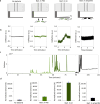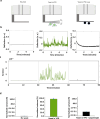An Optical Fiber-Based Nanomotion Sensor for Rapid Antibiotic and Antifungal Susceptibility Tests
- PMID: 38311846
- PMCID: PMC10941246
- DOI: 10.1021/acs.nanolett.3c03781
An Optical Fiber-Based Nanomotion Sensor for Rapid Antibiotic and Antifungal Susceptibility Tests
Abstract
The emergence of antibiotic and antifungal resistant microorganisms represents nowadays a major public health issue that might push humanity into a post-antibiotic/antifungal era. One of the approaches to avoid such a catastrophe is to advance rapid antibiotic and antifungal susceptibility tests. In this study, we present a compact, optical fiber-based nanomotion sensor to achieve this goal by monitoring the dynamic nanoscale oscillation of a cantilever related to microorganism viability. High detection sensitivity was achieved that was attributed to the flexible two-photon polymerized cantilever with a spring constant of 0.3 N/m. This nanomotion device showed an excellent performance in the susceptibility tests of Escherichia coli and Candida albicans with a fast response in a time frame of minutes. As a proof-of-concept, with the simplicity of use and the potential of parallelization, our innovative sensor is anticipated to be an interesting candidate for future rapid antibiotic and antifungal susceptibility tests and other biomedical applications.
Keywords: Optical fiber sensor; antibiotic/antifungal susceptibility test; nanomotion device; two-photon polymerization.
Conflict of interest statement
The authors declare no competing financial interest.
Figures





References
-
- Theuretzbacher U.; Gottwalt S.; Beyer P.; Butler M.; Czaplewski L.; Lienhardt C.; Moja L.; Paul M.; Paulin S.; Rex J. H.; Silver L. L.; Spigelman M.; Thwaites G. E.; Paccaud J.-P.; Harbarth S. Analysis of the clinical antibacterial and antituberculosis pipeline. Lancet Infectious Diseases 2019, 19, e40–e50. 10.1016/S1473-3099(18)30513-9. - DOI - PubMed
Publication types
MeSH terms
Substances
LinkOut - more resources
Full Text Sources
Medical
Research Materials

